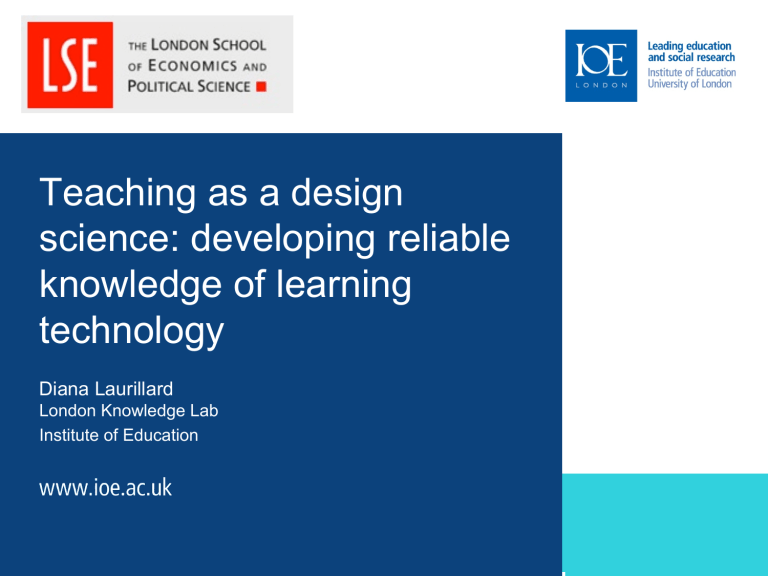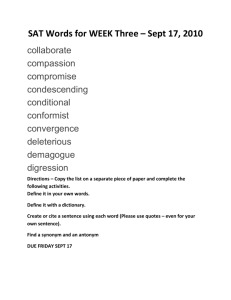Teaching as a design science: developing reliable knowledge of learning technology
advertisement

Teaching as a design science: developing reliable knowledge of learning technology Diana Laurillard London Knowledge Lab Institute of Education Teachers as an innovative professional learning community • Reconceptualising teaching as ‘a design science’ • Teachers building on the designs of others • Ar8cula8ng their pedagogy • Adop8ng, adap8ng, tes8ng, improving learning designs • Co-­‐crea8ng and sharing learning designs à A computa8onal representa8on of pedagogic design Sept 2012 cc: by-nc-sa Should learning design be supported computationally? It’s difficult, but it’s worth a try, because… Teachers need much more support than they get to make the most of learning technologies If they can learn together, collaborate, build on the work of others, they can build this knowledge Not in just in staff development courses, not from books, not through exhorta8on, but in the same way as other designers learn… That’s why we built à Sept 2012 cc: by-nc-sa The Learning Designer A TLRP-TEL project To help teachers Articulate their effective teaching ideas for others to adopt Adopt ‘pedagogical patterns’ of good teaching and open resources Model pedagogical and logistical benefits/disadvantages By developing design tools A ‘pedagogical patterns collector’ for capturing and articulating good pedagogy A’ learning design support tool’ for teachers to find, adopt, adapt, analyse, experiment, trial in practice, redesign, and share designs http://tinyurl.com/ppcollector3 https://sites.google.com/a/lkl.ac.uk/ldse/Home Sept 2012 cc: by-nc-sa Capturing pedagogy as design plans Short descrip8on Learning outcome Categorised teaching-­‐ learning ac8vi8es Sept 2012 cc: by-nc-sa Colour-­‐ coded content Black text ar8culates the teacher’s pedagogy Timings A computational representation Sept 2012 cc: by-nc-sa The Pedagogical Patterns Collector A library of paLerns to inspect, both generic and specific versions Black text captures pedagogy design Colour-­‐coded text iden8fies content parameters Sept 2012 cc: by-nc-sa Adopt/Adapt a teaching pattern Add link to an OER, e.g. a digital tool for prac8ce Read, Watch, Listen Investigate Discuss Practice Share Produce Export to Word [Moodle] Represent the teacher as present or not Adopt – Adapt – Import resources- Test and Sept 2012 cc: by-nc-sa Check the feedback on the overall distribu8on of learning ac8vity Adjust the type of learning ac8vity. Edit the instruc8ons. re-design - Export Comments on the PPC • [The pie-­‐chart] is one of the most useful features … it gives a good overview of the balance between different learning experiences • I rarely consider how the students' Ame is apporAoned … it's good to be made to think about this. • Seeing how the sessions are shaping up in such a visual medium …. would probably make me think more carefully about providing a mix of acAviAes Sept 2012 cc: by-nc-sa The Learning Designer A TLRP-TEL project To help teachers Articulate their effective teaching ideas for others to adopt Adopt ‘pedagogical patterns’ of good teaching and open resources Model pedagogical and logistical benefits/disadvantages By developing design tools A Pedagogical Pattern Collector for capturing and articulating good pedagogy The Learning Designer for teachers to find, adopt, adapt, analyse, experiment, trial in practice, redesign, and share designs http://tinyurl.com/ppcollector3 https://sites.google.com/a/lkl.ac.uk/ldse/Home Sept 2012 cc: by-nc-sa The Learning Designer overview Analysis: Timeline: Properties: The start screen: •• Charts of the overall Select Credit Importteachinghours or Create • learning Studentexperience activities, numbers typeswhat of outcomes learning, •• – Define Learning they do of experience of • and inDescription activity social •• personal, Define Designer timing reflection of or class • whole each Student one, feedback group • sizes, teacher workload – sequencing for initial design and for reuse Sept 2012 cc: by-nc-sa A theory-based framework of the learner learning Acquiring L L Learner C C concepts Talk, book, Teacher video, Web concepts Inquiring Modulate Generate L L Learner P P practice Learning through acquisition, instruction Learning through inquiry Sept 2012 cc: by-nc-sa A theory-based framework of the learner learning Teacher concepts L L Learner C C concepts Modulate Generate Modulate Generate Task/Feedback L L Learner P P practice Lab, Game, Learning Simula8on environment Actions Learning through practice with meaningful intrinsic feedback Sept 2012 cc: by-nc-sa A theory-based framework of the learner learning Acquiring Ideas, questions L L Learner C C concepts Teacher concepts Peer concepts Ideas, questions Inquiring Modulate Generate Modulate Generate Modulate Generate Outputs Learning environment Practising L L Learner P P practice Peer prac8ce Outputs Instructivism - Social constructivism – Experiential learning – Inquiry learning - Constructionism – Collaborative learning (Dewey, Vygotsky, Piaget, Gagné Bruner, Papert, Marton, Bransford…) Sept 2012 cc: by-nc-sa The Conversational Framework Teacher concepts Teacher communication cycle L L Learner C C concepts Peer communication cycle Modulate Generate Teacher practice cycle Modulate Generate Peer practice cycle Modulate Generate Learning environment Teacher modelling cycle L L Learner P P practice Peer modelling cycle Peer prac8ce Instructivism Social constructivism Experiential learning Constructionism Collaborative learning Peer concepts Inquiry learning Dewey, Vygotsky, Piaget, Gagné, Bruner, Papert, Marton, Bransford… Sept 2012 cc: by-nc-sa A theory-based framework of the learner learning Acquiring Teacher concepts Inquiring L L Learner C C concepts Discussing Peer concepts Producing Modulate Generate Modulate Generate Modulate Generate Learning environment L L Learner P P practice Peer prac8ce Practising Collaborating Instructivism - Social constructivism – Experiential learning – Inquiry learning - Constructionism – Collaborative learning (Dewey, Vygotsky, Piaget, Gagné Bruner, Papert, Marton, Bransford…) Sept 2012 cc: by-nc-sa Learning with technology Podcasts Acquiring Teacher concepts Modulate Generate Learning environment Sept 2012 cc: by-nc-sa Web Inquiring resources Producing Designs Produc8ons Skills Prac8ce Prac8sing Tools L L Learner C C concepts Webinar, Forum Peer concepts Collabora8on tools Peer prac8ce Discussing Modulate Generate L L Learner P P practice Collabora8ng Co-creating new pedagogies • Import exis8ng learning designs • Use advice and guidance • Consider alterna8ve designs • Adapt the design to own context • Analyse the designs • Re-­‐design – test – improve -­‐ share Sept 2012 cc: by-nc-sa Co-creating new pedagogies Import an exis8ng learning design Adapt an exis8ng learning design Consider advice and guidance on adapta8on Consider alterna8ve learning ac8vi8es Sept 2012 cc: by-nc-sa Analysing the design Interpreted in terms of the Conversa8onal Framework Sept 2012 cc: by-nc-sa Contras8ng teacher workload for own design and reuse Re-designing Use drop-­‐down menu to change teaching-­‐ learning ac8vi8es and analyse effect on learning experience and teacher 8me Sept 2012 cc: by-nc-sa Sharing… Once tested and evaluated with students, export (with metadata) to shared folder, website, community library, open repository… Sept 2012 cc: by-nc-sa Comments on the approach • Teachers respond posi8vely to the Learning Designer tools and see this as a way of improving teaching, and poten8ally of saving 8me • The Learning Designer concepts of sharing designs, reuse, adaptaAon, advice on TEL, analysis of the learning experience, suggesAons of design alternaAves, and categorisaAon of designs, were all welcomed by teachers • Teachers commented on the added value of the detailed descrip8ons of pedagogy, which enable them to have a more in-­‐depth conversa8on about their prac8ce and what makes a learning design more effec8ve Sept 2012 cc: by-nc-sa From 20thC to 21stC teacher? 40 35 30 25 20 15 10 5 0 20th C 21st C Teachers’ activities …shift …increase …shift fromfrom class in activity individual teaching to improve design to moreto the personalised co-design learning experience ofteaching learning Sept 2012 cc: by-nc-sa Modelling learning experience and teacher workload How can we estimate the effects of the decisions we make as we plan a course? We select the set of teaching and learning activities we intend to use These have consequences for the pedagogical benefits, and the comparative costs in terms of teachers’ workload The next slide shows how the intervening assumptions join up the decisions and consequences Sept 2012 cc: by-nc-sa Select Teaching-­‐Learning Ac8vi8es (TLAs): wiki, simula8on, e-­‐pordolio Define the type of learning each TLA offers Decide group size for each TLA Distribute learning hours across the selected TLAs Acquisi8on Distribu8on of Inquiry learner Discussion 8me across types of Prac8ce learning experienced Produc8on Sept 2012 cc: by-nc-sa Decide Teacher Time needed to prepare and present each TLA Input total credit hours, size of cohort Teacher 8me for: Design and prepara8on Class and online presenta8on Marking and learner support Comparison of pedagogical benefits, and costs in terms of teachers’ workload Conventional Student numbers Teacher hrs per student More ac8ve learning Blended Acquisi8on Acquisi8on Inquiry Inquiry Discussion Discussion Prac8ce Prac8ce Produc8on Produc8on Yr 1 Yr 2 Typical Yr 1 Yr 2 Typical 15 15 30 15 15 30 3.5 1.8 1.2 5.2 2.3 0.4 Lower per capita costs in a typical year for large numbers But who funds the up-front design and development costs? Sept 2012 cc: by-nc-sa Modelling the costs for increasing student cohort size 3.5 3 Teacher days per student 2.5 2 Conven8onal 1.5 Open Mode 1 0.5 0 30 60 90 120 150 Cohort size What does this mean for the business model for MOOCs? Sept 2012 cc: by-nc-sa What issues must the Learning Designer also address? • Complexity • • • “It’s very overwhelming … there’s a lot going on and to Poten8ally a ntot ool ow f hat management control think about. I’m sure all the terms mean. I mean I don’t nderstand between produc8on “My ounly worry is tthe hat diifference t [the Learning Designer] turns aind nto Interpretability o f a nalysis prac8ce. Let’s hrave a look […] Yes – OaK get it. It Ybes I see a an insAtuAonal equisite rather than n –o IpAon. ecomes the difference. tool, Probably wte han need bit moore help here w ith measurement rave ather a uaseful rganisaAonal tool “I t hink i t's c ute t o h p ie c harts, i t's n eat [ ...] I w ould g o The n eed f or a t opic-­‐oriented f ocus explana8ons a nd e xamples. B ut o nce y ou g et i nto t he t ool it that aallows some cmriAcal self reflecAon m on p8racAce. I know back nd s quidge y s tuff, r eorganise y me b ecause I “My p roblem w ith tlhe tool biut s that the pedagogy is there, neutral of isn’t she o dgifficult” that t oal i s t he aLer, s oMware, o nce o ut c an would know that it awpproach ould be tao gtood thing to hlearning ave a mix of the t opic w hile t he eaching a nd become so steducAve to forms gather informaAon for that's departments, all o f t hese hings ( i.e. o f l earning). B ut because requires a t opic a pproach a nd t his t ool d oesn’t h elp w ith is policy m akers, e tc, a nd t he i nformaAon t hat i s p roduced I this think it's a good thing. If I didn't believe that this was a a pproach” probably ONLY useful individual eachers, not tehat ducaAon good thing, then you wfor ould show mte a pie chart was ministers, etc” 90% of one thing I would s8ll think it's ok” Sept 2012 cc: by-nc-sa Teachers as innovative cocreators of technology-based pedagogies Features of teaching as ‘a design science’: • Teachers adop8ng, adap8ng, tes8ng, improving, sharing learning designs • Teaching as collabora8ve learning, supported by online collabora8ve design tools and repositories • A theory-­‐based computa8onal representa8on of pedagogic design and teacher workload that migrates across subjects Sept 2012 cc: by-nc-sa Further details… Teaching as a Design Science: Building pedagogical patterns for learning and technology(Routledge, 2012) Sept 2012 cc: by-nc-sa The LDSE project team Oxford Liz Masterman (CoPI) Marion Manton (CoPI) Joanna Wild (RF) Birkbeck/LKL IOE/LKL George Magooulas (CoPI) Patricia Charlton Dionisis Dimakopoulos Brock Craft (RF) Diana Laurillard (PI) Dejan Ljubojevic (RF) LondonMet Tom Boyle (CoPI) RVC LSE Steve Ryan (CoPI) Ed Whitley Roser Pujadas (PhD Student) Sept 2012 cc: by-nc-sa Kim Whittlestone (CoPI) Stephen May Carrie Roder (PhD Student)



